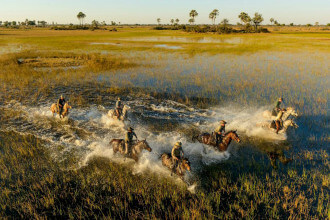Ifotaka is a community-managed forest reserve protecting 22,000 ha of spiny thicket and gallery forest in the remote south of Madagascar. With two distinctive forest types including the most unusual forest on Earth, 5 species of lemur, and scores of rare endemic birds and reptiles, the wildlife experience here is outstanding.
This little-known forest reserve features a strange and ethereal habitat found nowhere else on the planet: the spiny thicket. It's so bizarre that biologists can't decide whether it's a forest or a desert, hence its name. 95% of the plants in this almost alien habitat are totally unique. It features two of Madagascar's most celebrated characters - the famed dancing sifakas (recently appearing on BBC's Planet Earth 2) and perhaps the most iconic of all lemurs, the cartoon-like ring-tailed.
Walk amongst prehistoric octopus trees in the otherworldly spiny thicket in the early morning to spot rare endemic birds such as the gorgeous crested coua, the oddball hook-billed vanga, and the highly localised giant coua. Explore sacred forests where the ancestral tombs of the Antandroy tribe are interspersed with 500 year-old giant baobab trees. Wander amongst a totally unfamiliar landscape of strange plants that host feeding sunbirds, paradise flycatchers and noisy vasa parrots; there really is nothing else remotely like this habitat on Earth. No trip to Madagascar is complete without spotting the country's two most notorious lemur species: the Verreaux's sifaka and the ring-tailed lemur. Both can be seen at Ifotaka. Watch as the Verreaux's launches from one thorn-clad octopus tree to the next with total ease, then as they 'dance' on two feet across stretches of open ground. You will find the ring-taileds in the sacred gallery forest along the Mandrare River, access by boat from the River Camp, where large troops of play in plain sight.
Night walks here are excellent. As the diurnal species turn in for the night, the thicket resounds with the clamour of its nocturnal residents. You will spot two tiny species of mouse lemur (grey and grey-brown) bouncing between tree trunks, highly vocal white-footed sportive lemur (or Lepilemur) and sleepy sifakas. Night time is also the best period to look for chameleons sleeping at the ends of branches out of reach from predators, as well as scops owls and, with a little luck, the scarce white-browed owl.
The Camp also organizes visits to the colourful local market as well as schools and clinics that they sponsor. Nearby there is a local (more private) version of the famed ‘Avenue of the Baobabs’ where sundowners are served. Watching the sun set and moon rise with a view across the Baobabs to the mountains beyond is a magical experience. In the evening the local village may come to perform beautiful traditional dances, accompanied by singing and music. Song and dance is at the heart of Antandroy culture and is used to accompany the major rituals and events of everyday life.
For further information on Madagascar's iconic lemurs, please see our
blog post all about these unbelievable creatures.
Ifotaka Community Forest: where to stay
Mandrare River Camp
: The excellent solar-powered
Mandrare River Camp offers seven luxurious semi-permanent tents beside the Mandrare River, with fantastic access to the spiny forest and the wide variety of wildlife within it. Accommodation, food and service are all of a very high standard; various activities and cultural visits are available.
 2023 Guest Reviews
2023 Guest Reviews
 Kruger Walking Safari
Kruger Walking Safari
 Botswana Trip Report
Botswana Trip Report
















